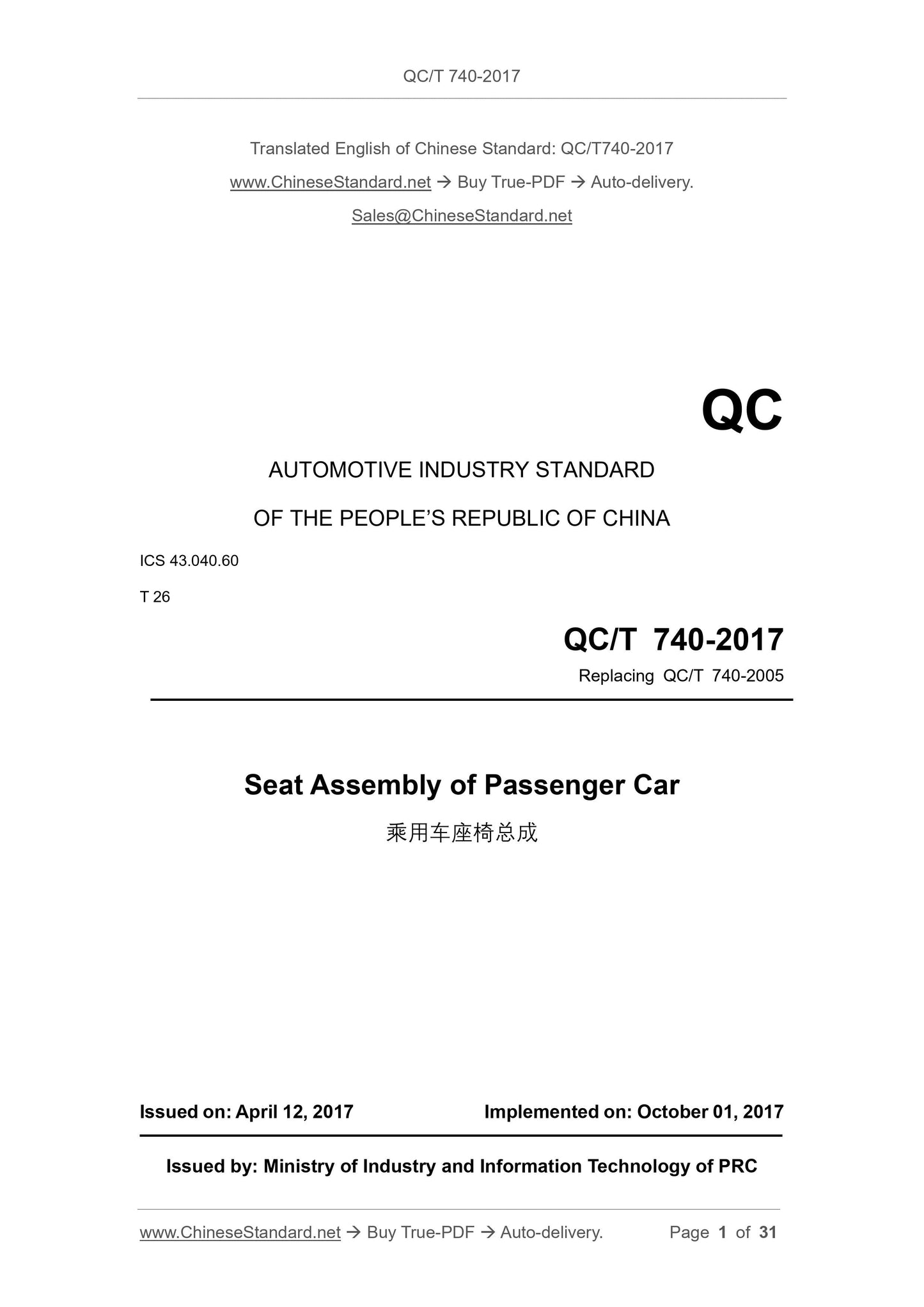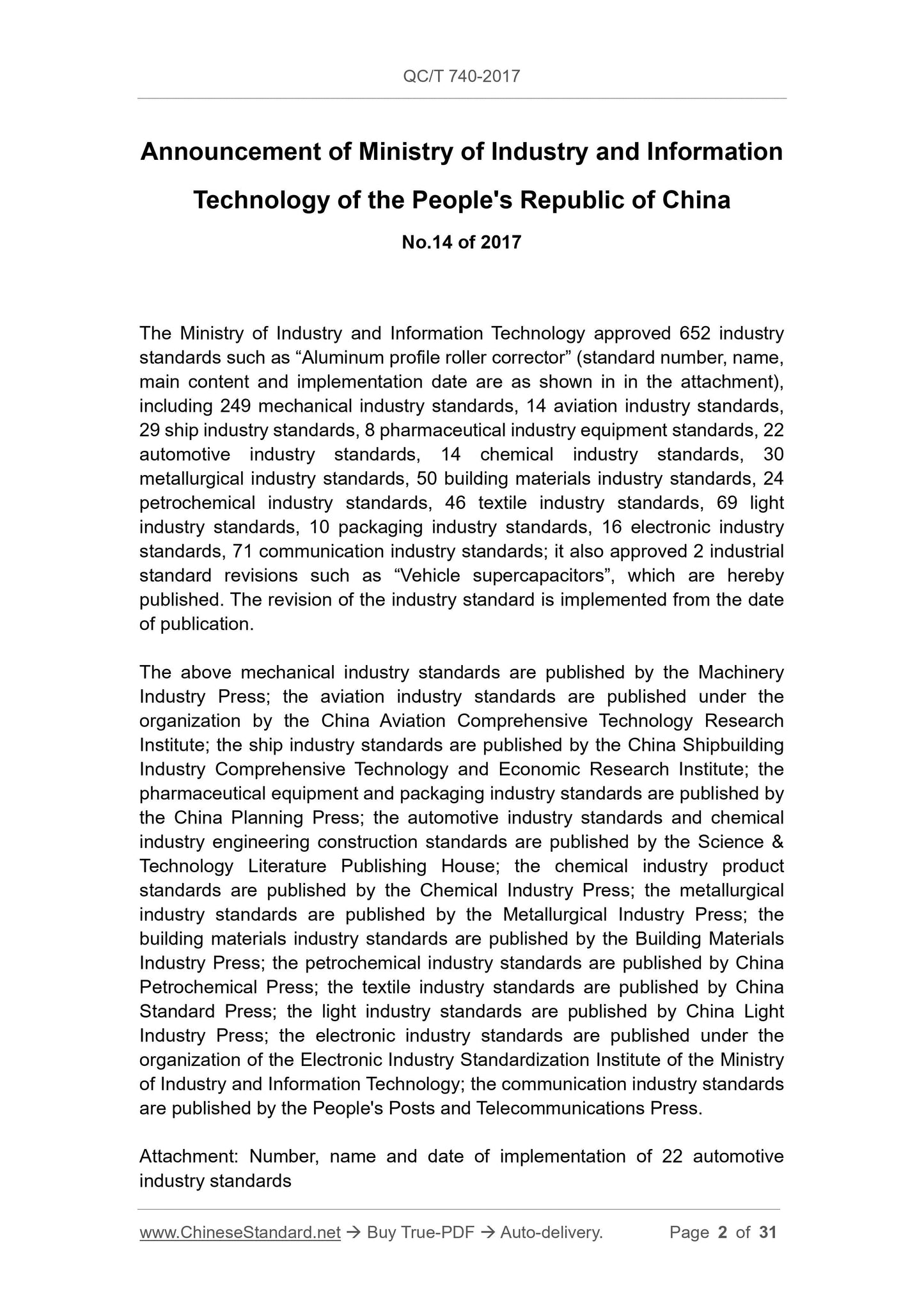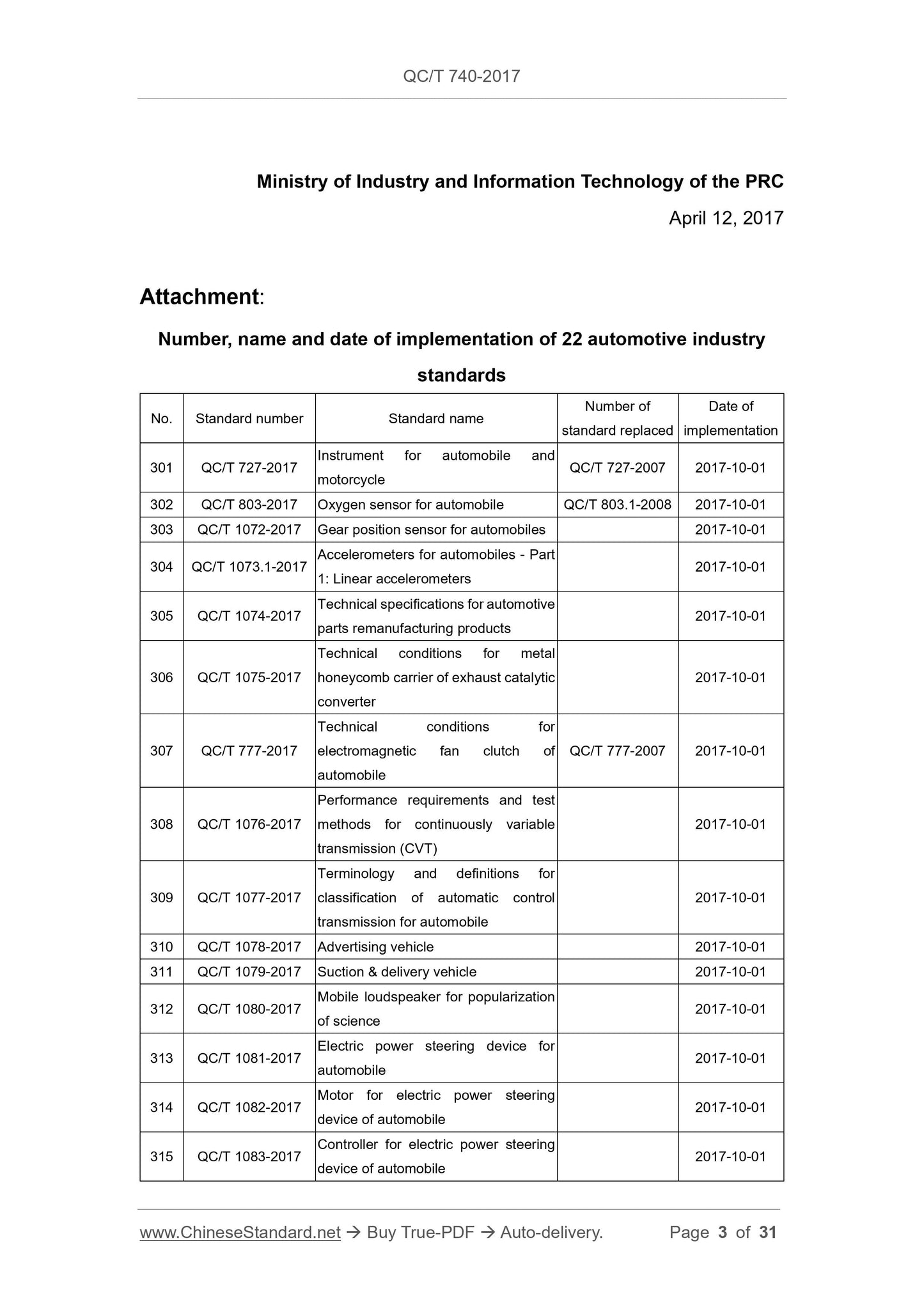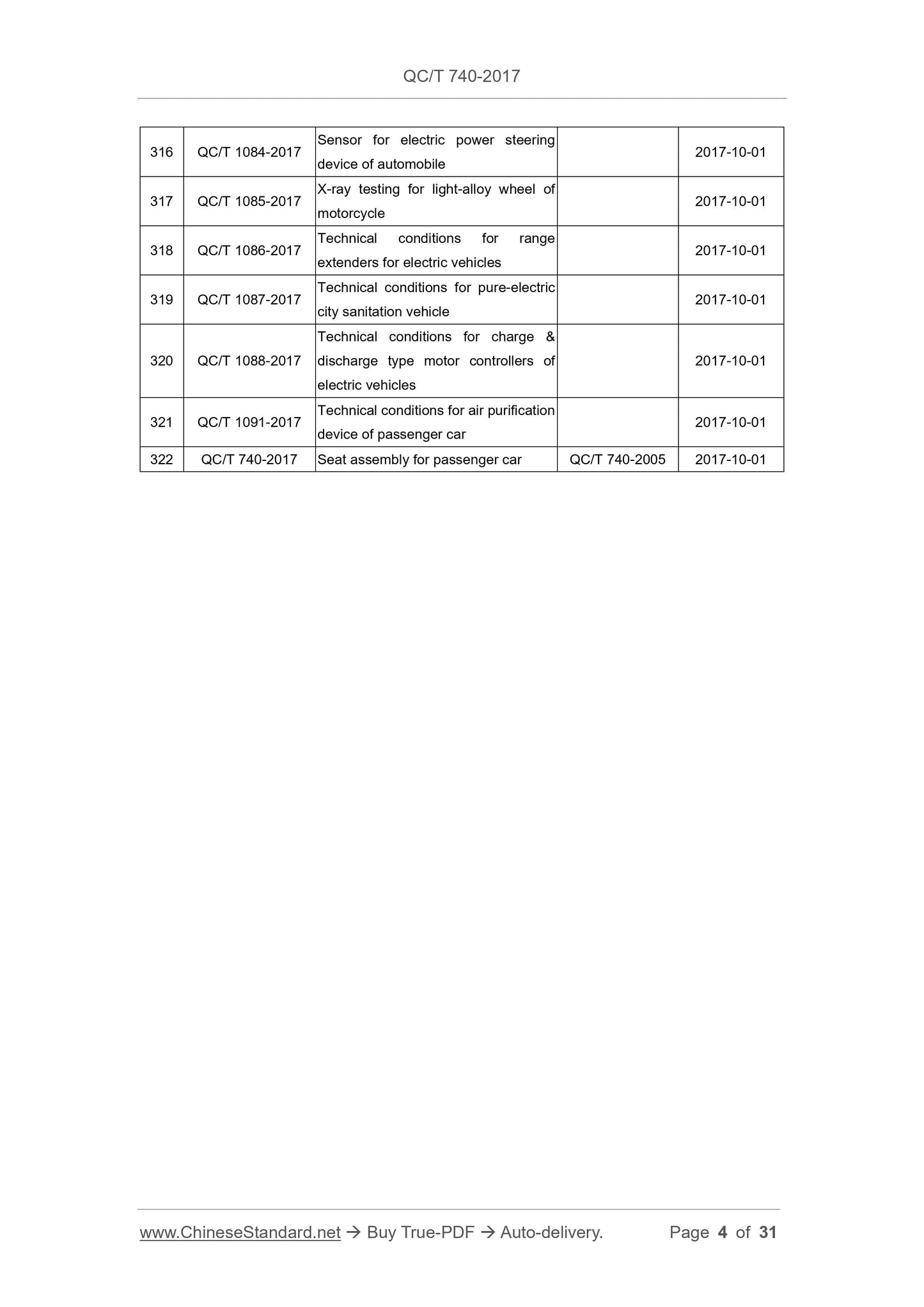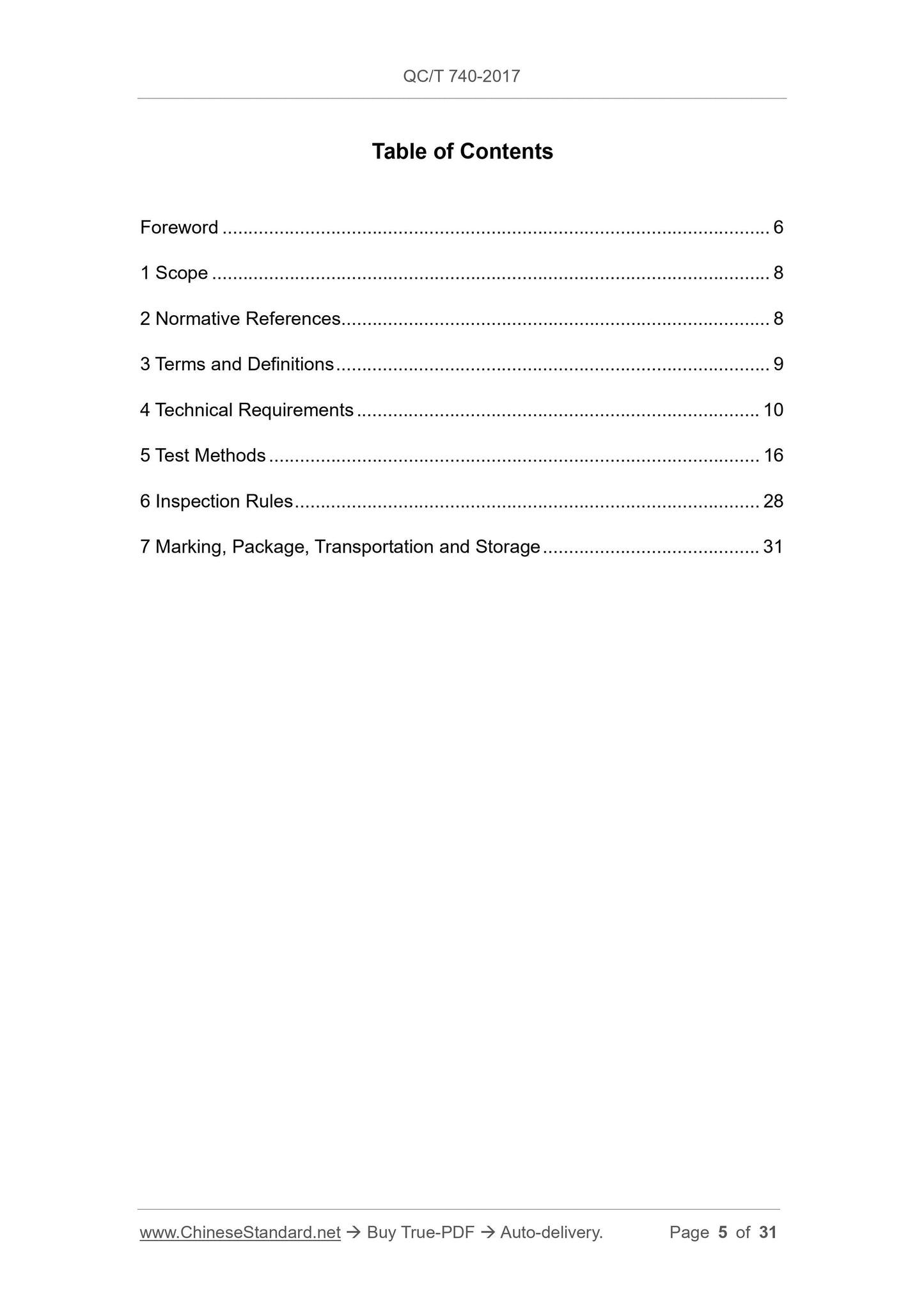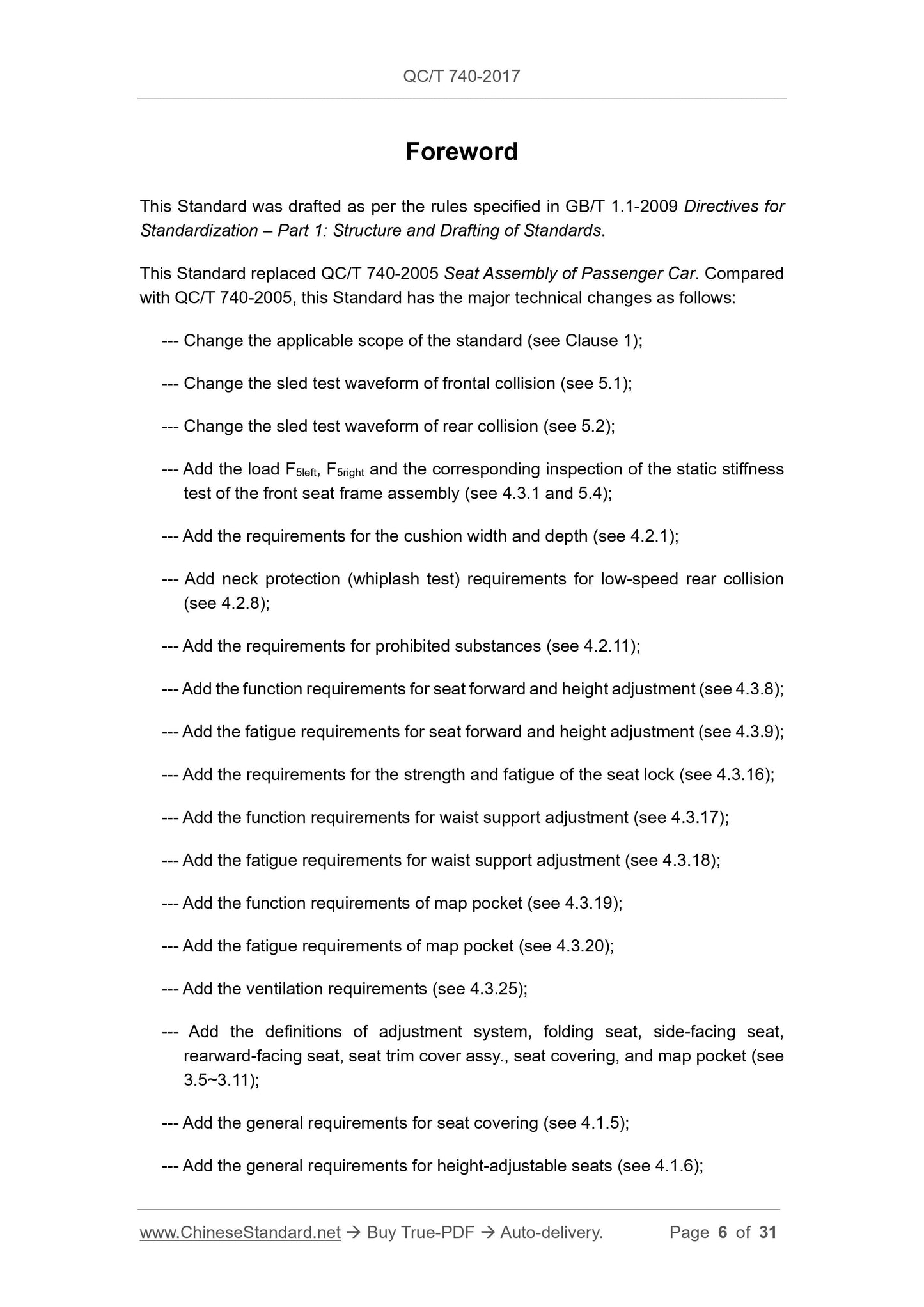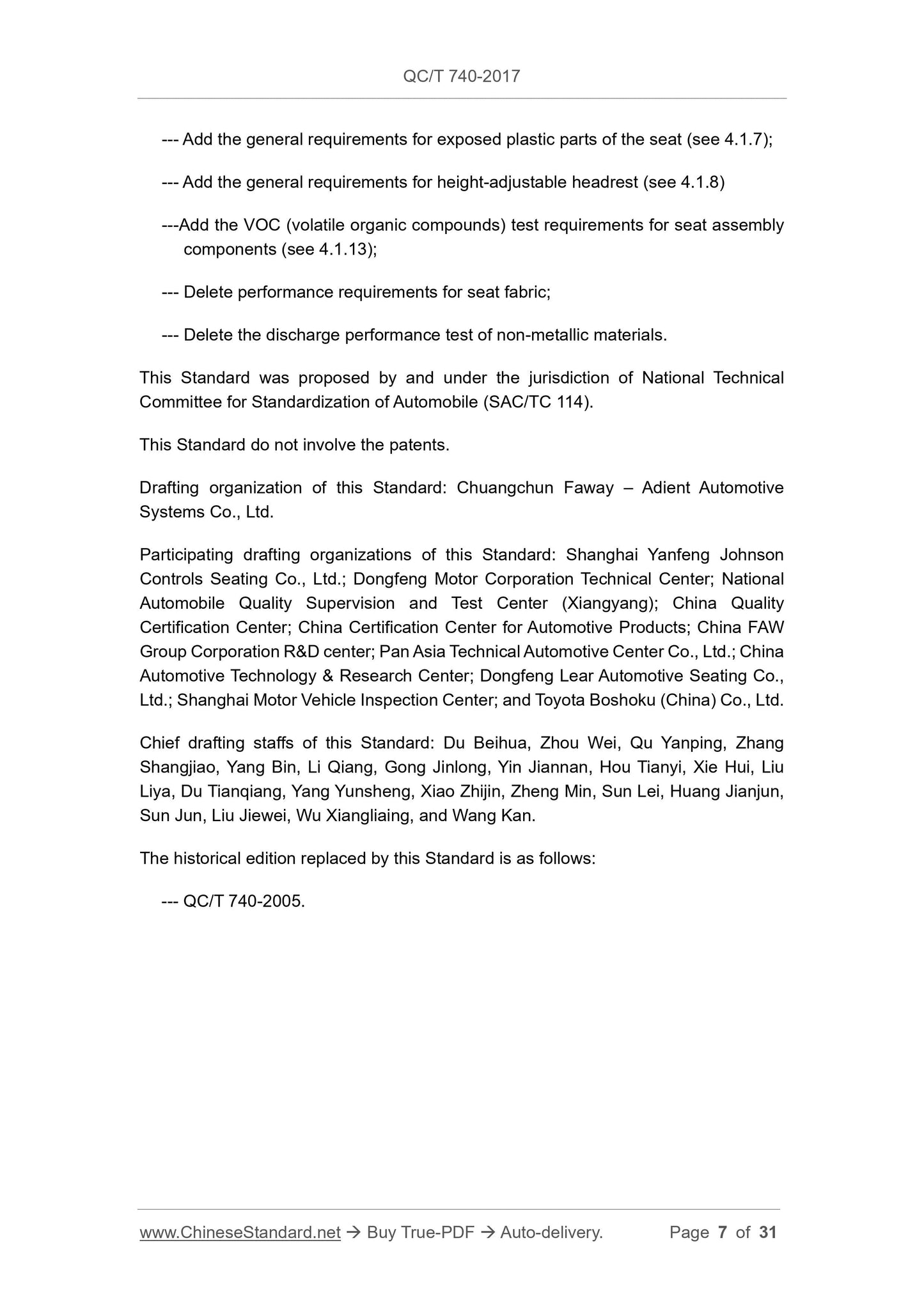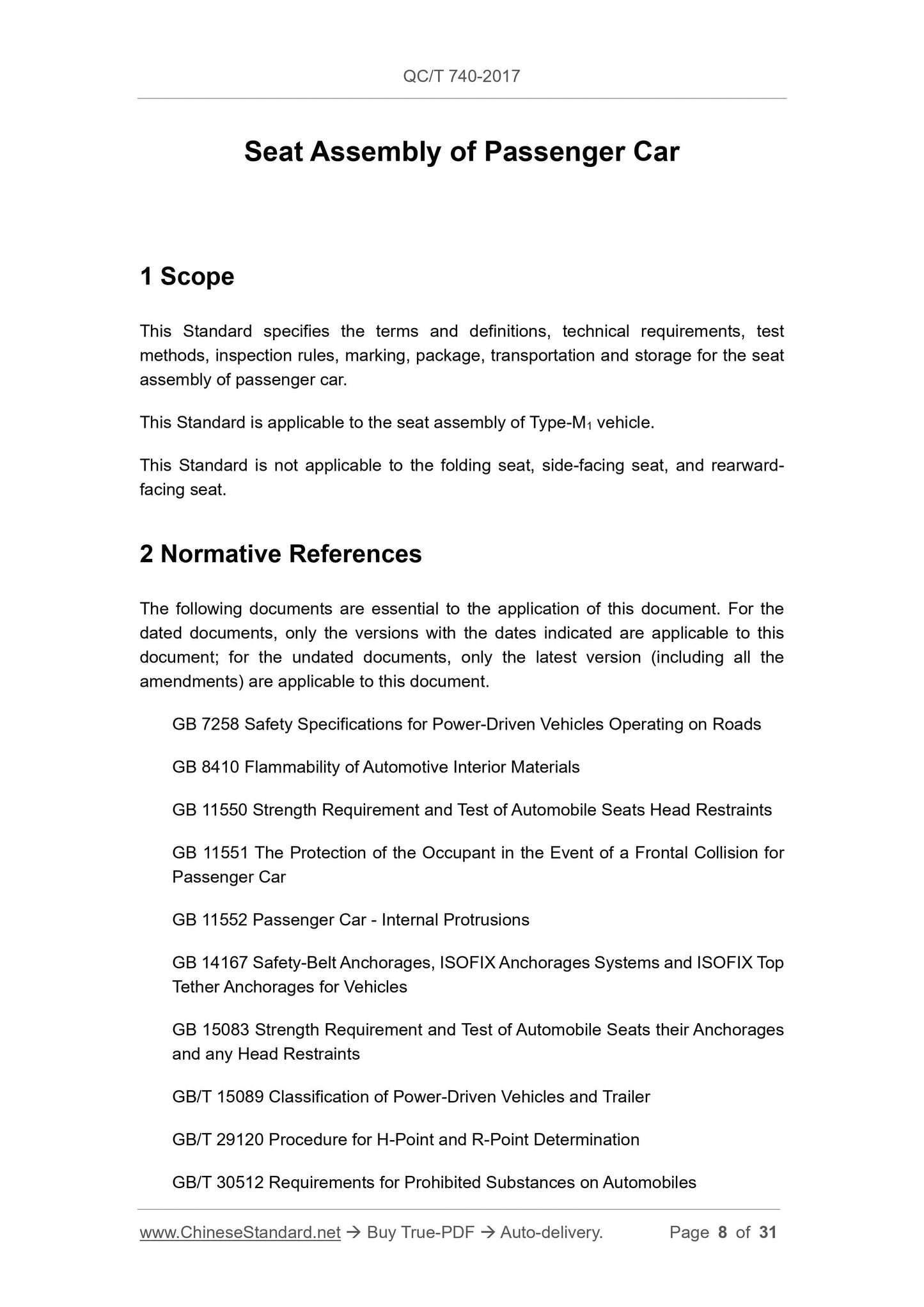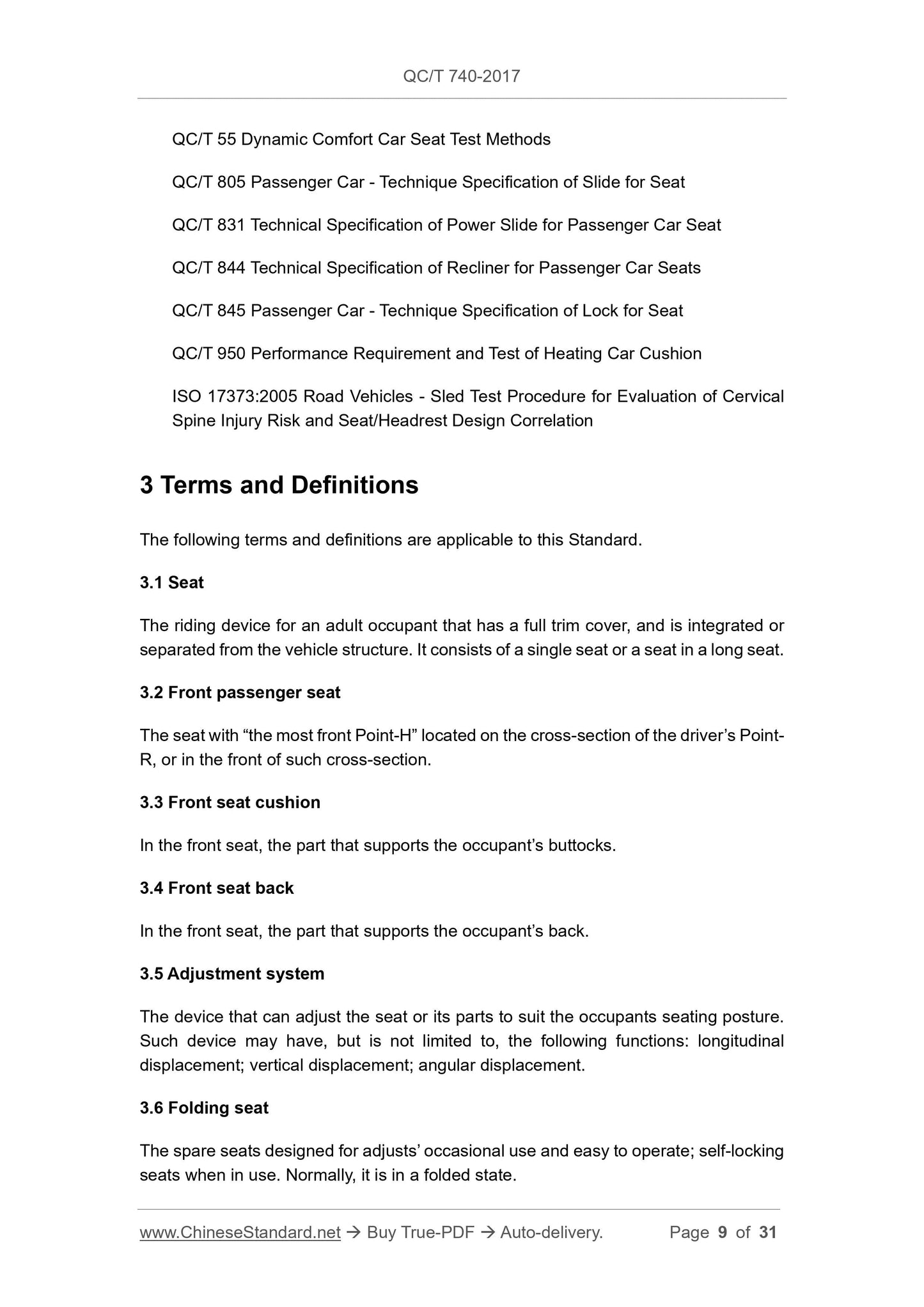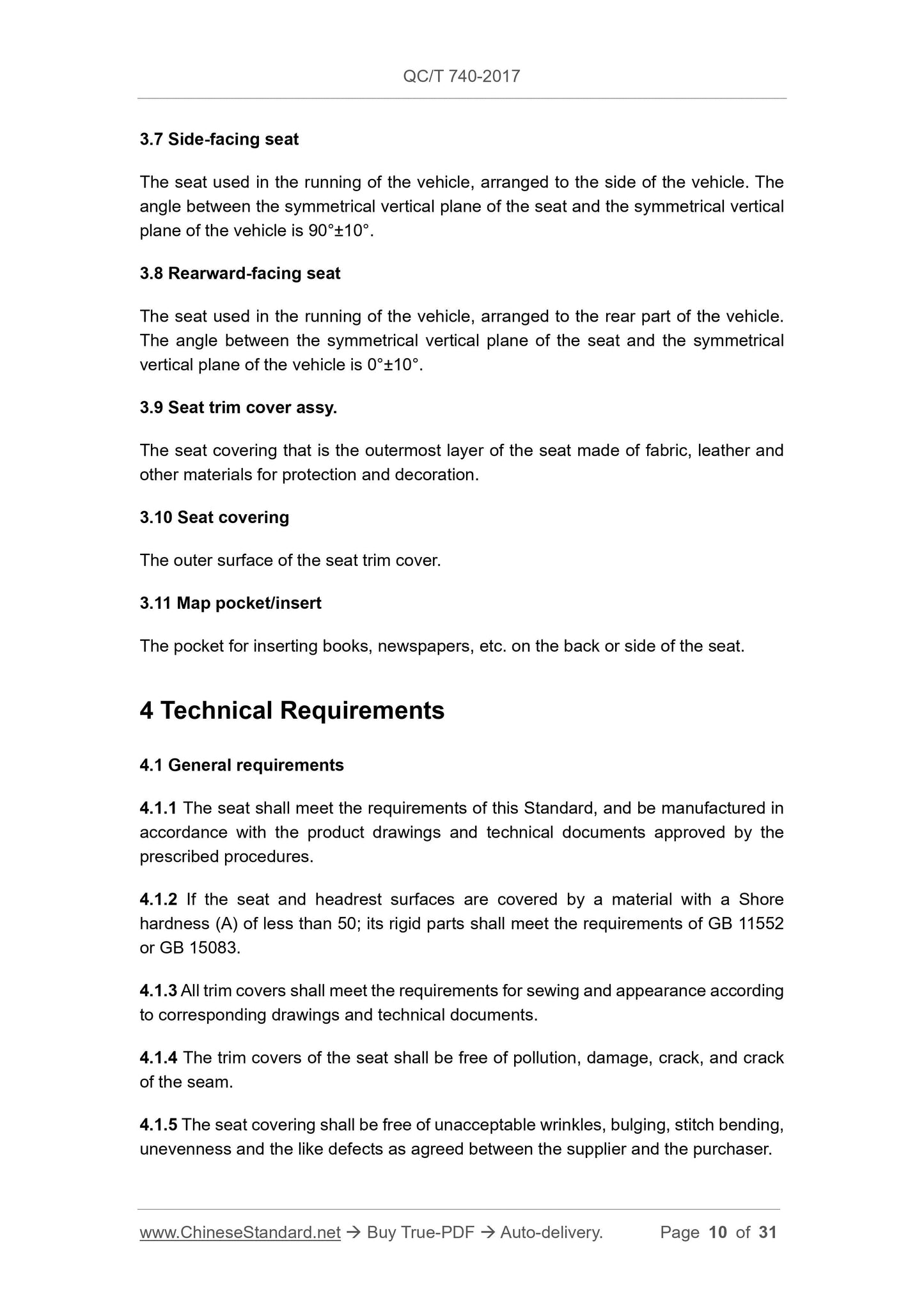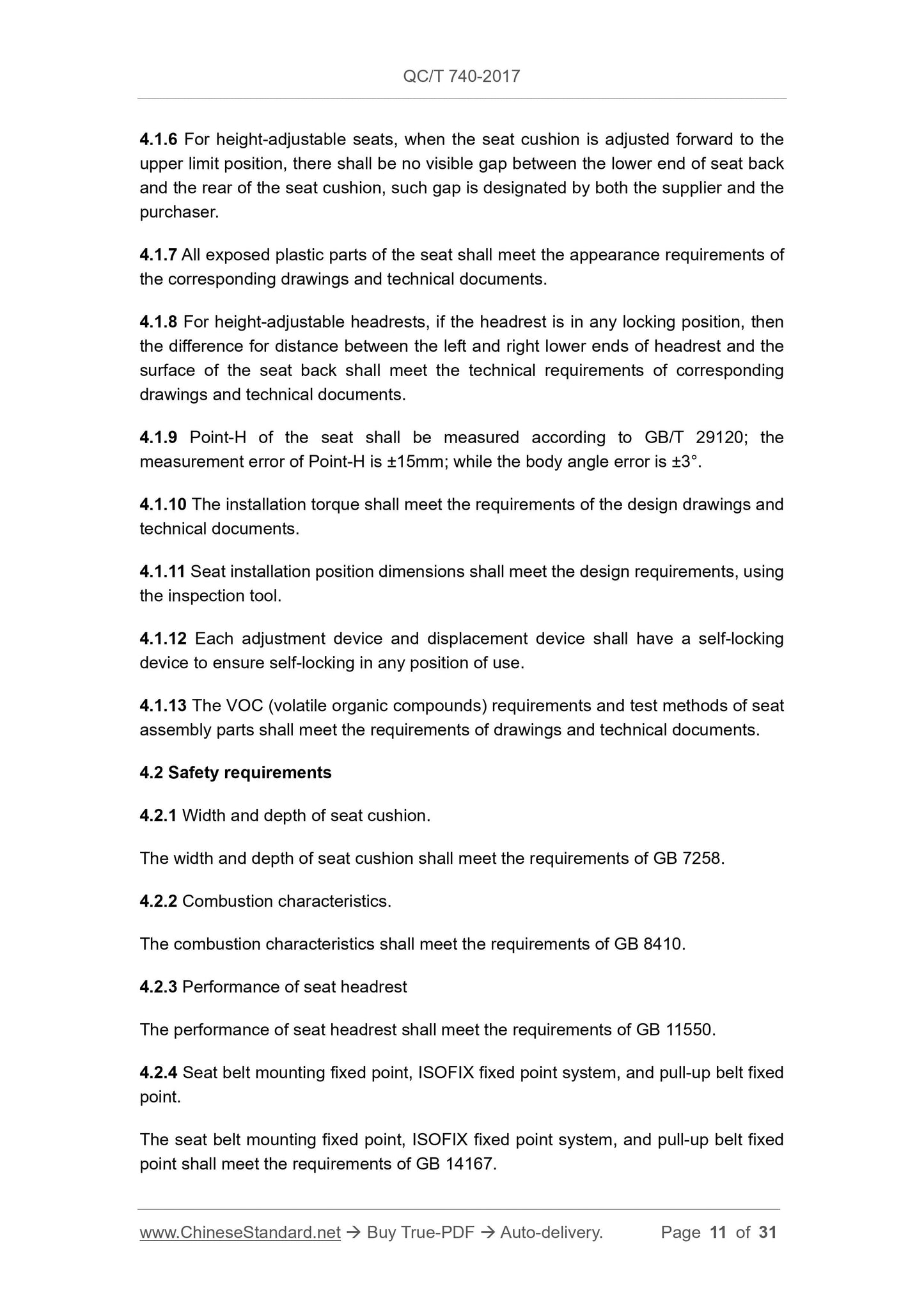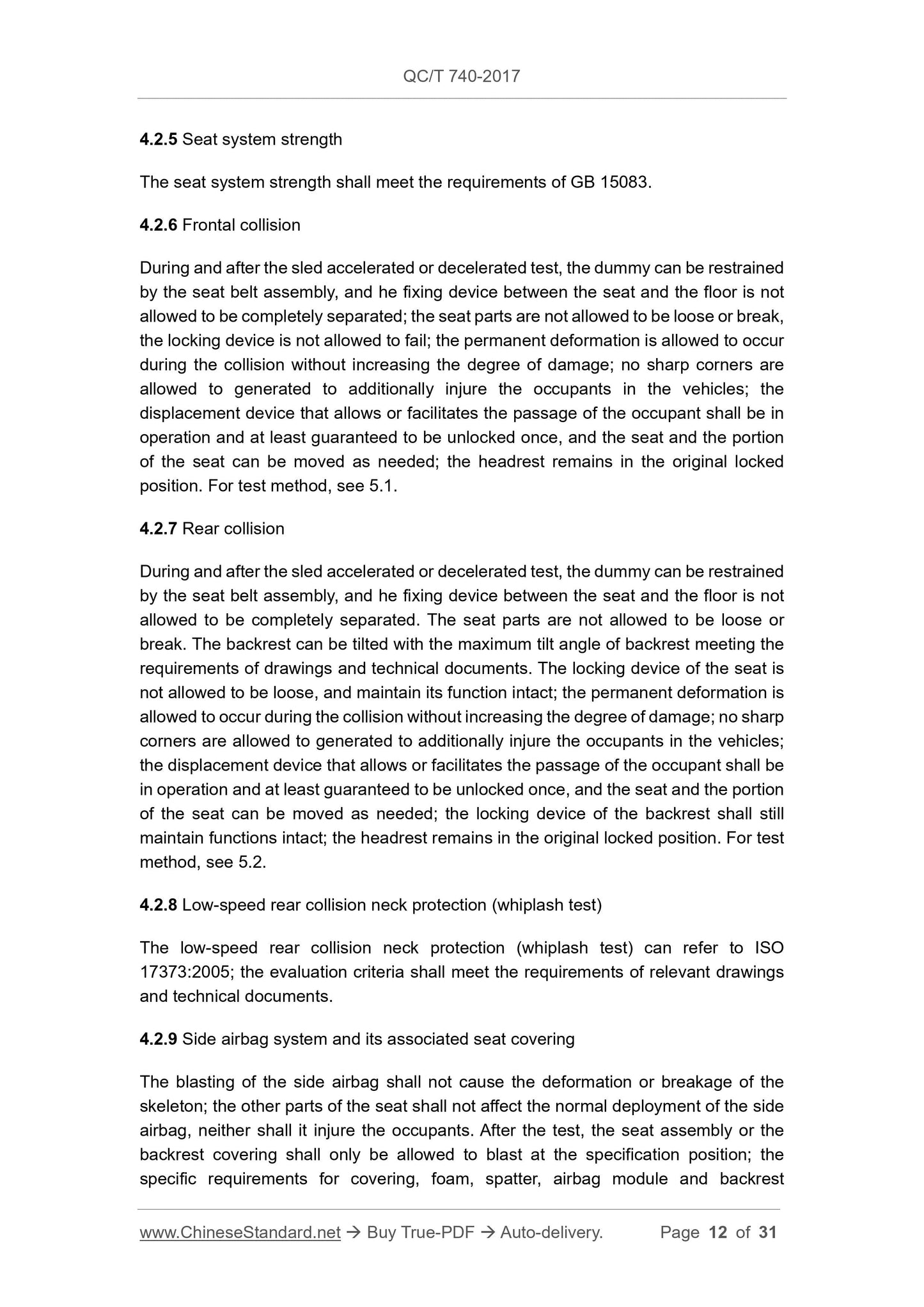1
/
of
12
PayPal, credit cards. Download editable-PDF & invoice in 1 second!
QC/T 740-2017 English PDF (QCT740-2017)
QC/T 740-2017 English PDF (QCT740-2017)
Regular price
$155.00 USD
Regular price
Sale price
$155.00 USD
Unit price
/
per
Shipping calculated at checkout.
Couldn't load pickup availability
Delivery: 3 seconds. Download true-PDF + Invoice.
Get QUOTATION in 1-minute: Click QC/T 740-2017
Historical versions: QC/T 740-2017
Preview True-PDF (Reload/Scroll if blank)
QC/T 740-2017: Seat assembly of passenger car
QC/T 740-2017
AUTOMOTIVE INDUSTRY STANDARD
OF THE PEOPLE’S REPUBLIC OF CHINA
ICS 43.040.60
T 26
Replacing QC/T 740-2005
Seat Assembly of Passenger Car
ISSUED ON: APRIL 12, 2017
IMPLEMENTED ON: OCTOBER 01, 2017
Issued by: Ministry of Industry and Information Technology of PRC
Ministry of Industry and Information Technology of the PRC
April 12, 2017
Attachment:
Number, name and date of implementation of 22 automotive industry
standards
No. Standard number Standard name Number of standard replaced
Date of
implementation
301 QC/T 727-2017 Instrument for automobile and motorcycle QC/T 727-2007 2017-10-01
302 QC/T 803-2017 Oxygen sensor for automobile QC/T 803.1-2008 2017-10-01
303 QC/T 1072-2017 Gear position sensor for automobiles 2017-10-01
304 QC/T 1073.1-2017 Accelerometers for automobiles - Part 1: Linear accelerometers 2017-10-01
305 QC/T 1074-2017 Technical specifications for automotive parts remanufacturing products 2017-10-01
306 QC/T 1075-2017
Technical conditions for metal
honeycomb carrier of exhaust catalytic
converter
2017-10-01
307 QC/T 777-2017
Technical conditions for
electromagnetic fan clutch of
automobile
QC/T 777-2007 2017-10-01
308 QC/T 1076-2017
Performance requirements and test
methods for continuously variable
transmission (CVT)
2017-10-01
309 QC/T 1077-2017
Terminology and definitions for
classification of automatic control
transmission for automobile
2017-10-01
310 QC/T 1078-2017 Advertising vehicle 2017-10-01
311 QC/T 1079-2017 Suction and delivery vehicle 2017-10-01
312 QC/T 1080-2017 Mobile loudspeaker for popularization of science 2017-10-01
313 QC/T 1081-2017 Electric power steering device for automobile 2017-10-01
314 QC/T 1082-2017 Motor for electric power steering device of automobile 2017-10-01
315 QC/T 1083-2017 Controller for electric power steering device of automobile 2017-10-01
Table of Contents
Foreword ... 6
1 Scope ... 8
2 Normative References ... 8
3 Terms and Definitions ... 9
4 Technical Requirements ... 10
5 Test Methods ... 16
6 Inspection Rules ... 28
7 Marking, Package, Transportation and Storage ... 31
Seat Assembly of Passenger Car
1 Scope
This Standard specifies the terms and definitions, technical requirements, test
methods, inspection rules, marking, package, transportation and storage for the seat
assembly of passenger car.
This Standard is applicable to the seat assembly of Type-M1 vehicle.
This Standard is not applicable to the folding seat, side-facing seat, and rearward-
facing seat.
2 Normative References
The following documents are essential to the application of this document. For the
dated documents, only the versions with the dates indicated are applicable to this
document; for the undated documents, only the latest version (including all the
amendments) are applicable to this document.
GB 7258 Safety Specifications for Power-Driven Vehicles Operating on Roads
GB 8410 Flammability of Automotive Interior Materials
GB 11550 Strength Requirement and Test of Automobile Seats Head Restraints
GB 11551 The Protection of the Occupant in the Event of a Frontal Collision for
Passenger Car
GB 11552 Passenger Car - Internal Protrusions
GB 14167 Safety-Belt Anchorages, ISOFIX Anchorages Systems and ISOFIX Top
Tether Anchorages for Vehicles
GB 15083 Strength Requirement and Test of Automobile Seats their Anchorages
and any Head Restraints
GB/T 15089 Classification of Power-Driven Vehicles and Trailer
GB/T 29120 Procedure for H-Point and R-Point Determination
GB/T 30512 Requirements for Prohibited Substances on Automobiles
3.7 Side-facing seat
The seat used in the running of the vehicle, arranged to the side of the vehicle. The
angle between the symmetrical vertical plane of the seat and the symmetrical vertical
plane of the vehicle is 90°±10°.
3.8 Rearward-facing seat
The seat used in the running of the vehicle, arranged to the rear part of the vehicle.
The angle between the symmetrical vertical plane of the seat and the symmetrical
vertical plane of the vehicle is 0°±10°.
3.9 Seat trim cover assy.
The seat covering that is the outermost layer of the seat made of fabric, leather and
other materials for protection and decoration.
3.10 Seat covering
The outer surface of the seat trim cover.
3.11 Map pocket/insert
The pocket for inserting books, newspapers, etc. on the back or side of the seat.
4 Technical Requirements
4.1 General requirements
4.1.1 The seat shall meet the requirements of this Standard, and be manufactured in
accordance with the product drawings and technical documents approved by the
prescribed procedures.
4.1.2 If the seat and headrest surfaces are covered by a material with a Shore
hardness (A) of less than 50; its rigid parts shall meet the requirements of GB 11552
or GB 15083.
4.1.3 All trim covers shall meet the requirements for sewing and appearance according
to corresponding drawings and technical documents.
4.1.4 The trim covers of the seat shall be free of pollution, damage, crack, and crack
of the seam.
4.1.5 The seat covering shall be free of unacceptable wrinkles, bulging, stitch bending,
unevenness and the like defects as agreed between the supplier and the purchaser.
4.2.5 Seat system strength
The seat system strength shall meet the requirements of GB 15083.
4.2.6 Frontal collision
During and after the sled accelerated or decelerated test, the dummy can be restrained
by the seat belt assembly, and he fixing device between the seat and the floor is not
allowed to be completely separated; the seat parts are not allowed to be loose or break,
the locking device is not allowed to fail; the permanent deformation is allowed to occur
during the collision without increasing the degree of damage; no sharp corners are
allowed to generated to additionally injure the occupants in the vehicles; the
displacement device that allows or facilitates the passage of the occupant shall be in
operation and at least guaranteed to be unlocked once, and the seat and the portion
of the seat can be moved as needed; the headrest remains in the original locked
position. For test method, see 5.1.
4.2.7 Rear collision
During and after the sled accelerated or decelerated test, the dummy can be restrained
by the seat belt assembly, and he fixing device between the seat and the floor is not
allowed to be completely separated. The seat parts are not allowed to be loose or
break. The backrest can be tilted with the maximum tilt angle of backrest meeting the
requirements of drawings and technical documents. The locking device of the seat is
not allowed to be loose, and maintain its function intact; the permanent deformation is
allowed to occur during the collision without increasing the degree of damage; no sharp
corners are allowed to generated to additionally injure the occupants in the vehicles;
the displacement device that allows or facilitates the passage of the occupant shall be
in operation and at least guaranteed to be unlocked once, and the seat and the portion
of the seat can be moved as needed; the locking device of the backrest shall still
maintain functions intact; the headrest remains in the original locked position. For test
method, see 5.2.
4.2.8 Low-speed rear collision neck protection (whiplash test)
The low-speed rear collision neck protection (whiplash test) can refer to ISO
17373:2005; the evalua...
Get QUOTATION in 1-minute: Click QC/T 740-2017
Historical versions: QC/T 740-2017
Preview True-PDF (Reload/Scroll if blank)
QC/T 740-2017: Seat assembly of passenger car
QC/T 740-2017
AUTOMOTIVE INDUSTRY STANDARD
OF THE PEOPLE’S REPUBLIC OF CHINA
ICS 43.040.60
T 26
Replacing QC/T 740-2005
Seat Assembly of Passenger Car
ISSUED ON: APRIL 12, 2017
IMPLEMENTED ON: OCTOBER 01, 2017
Issued by: Ministry of Industry and Information Technology of PRC
Ministry of Industry and Information Technology of the PRC
April 12, 2017
Attachment:
Number, name and date of implementation of 22 automotive industry
standards
No. Standard number Standard name Number of standard replaced
Date of
implementation
301 QC/T 727-2017 Instrument for automobile and motorcycle QC/T 727-2007 2017-10-01
302 QC/T 803-2017 Oxygen sensor for automobile QC/T 803.1-2008 2017-10-01
303 QC/T 1072-2017 Gear position sensor for automobiles 2017-10-01
304 QC/T 1073.1-2017 Accelerometers for automobiles - Part 1: Linear accelerometers 2017-10-01
305 QC/T 1074-2017 Technical specifications for automotive parts remanufacturing products 2017-10-01
306 QC/T 1075-2017
Technical conditions for metal
honeycomb carrier of exhaust catalytic
converter
2017-10-01
307 QC/T 777-2017
Technical conditions for
electromagnetic fan clutch of
automobile
QC/T 777-2007 2017-10-01
308 QC/T 1076-2017
Performance requirements and test
methods for continuously variable
transmission (CVT)
2017-10-01
309 QC/T 1077-2017
Terminology and definitions for
classification of automatic control
transmission for automobile
2017-10-01
310 QC/T 1078-2017 Advertising vehicle 2017-10-01
311 QC/T 1079-2017 Suction and delivery vehicle 2017-10-01
312 QC/T 1080-2017 Mobile loudspeaker for popularization of science 2017-10-01
313 QC/T 1081-2017 Electric power steering device for automobile 2017-10-01
314 QC/T 1082-2017 Motor for electric power steering device of automobile 2017-10-01
315 QC/T 1083-2017 Controller for electric power steering device of automobile 2017-10-01
Table of Contents
Foreword ... 6
1 Scope ... 8
2 Normative References ... 8
3 Terms and Definitions ... 9
4 Technical Requirements ... 10
5 Test Methods ... 16
6 Inspection Rules ... 28
7 Marking, Package, Transportation and Storage ... 31
Seat Assembly of Passenger Car
1 Scope
This Standard specifies the terms and definitions, technical requirements, test
methods, inspection rules, marking, package, transportation and storage for the seat
assembly of passenger car.
This Standard is applicable to the seat assembly of Type-M1 vehicle.
This Standard is not applicable to the folding seat, side-facing seat, and rearward-
facing seat.
2 Normative References
The following documents are essential to the application of this document. For the
dated documents, only the versions with the dates indicated are applicable to this
document; for the undated documents, only the latest version (including all the
amendments) are applicable to this document.
GB 7258 Safety Specifications for Power-Driven Vehicles Operating on Roads
GB 8410 Flammability of Automotive Interior Materials
GB 11550 Strength Requirement and Test of Automobile Seats Head Restraints
GB 11551 The Protection of the Occupant in the Event of a Frontal Collision for
Passenger Car
GB 11552 Passenger Car - Internal Protrusions
GB 14167 Safety-Belt Anchorages, ISOFIX Anchorages Systems and ISOFIX Top
Tether Anchorages for Vehicles
GB 15083 Strength Requirement and Test of Automobile Seats their Anchorages
and any Head Restraints
GB/T 15089 Classification of Power-Driven Vehicles and Trailer
GB/T 29120 Procedure for H-Point and R-Point Determination
GB/T 30512 Requirements for Prohibited Substances on Automobiles
3.7 Side-facing seat
The seat used in the running of the vehicle, arranged to the side of the vehicle. The
angle between the symmetrical vertical plane of the seat and the symmetrical vertical
plane of the vehicle is 90°±10°.
3.8 Rearward-facing seat
The seat used in the running of the vehicle, arranged to the rear part of the vehicle.
The angle between the symmetrical vertical plane of the seat and the symmetrical
vertical plane of the vehicle is 0°±10°.
3.9 Seat trim cover assy.
The seat covering that is the outermost layer of the seat made of fabric, leather and
other materials for protection and decoration.
3.10 Seat covering
The outer surface of the seat trim cover.
3.11 Map pocket/insert
The pocket for inserting books, newspapers, etc. on the back or side of the seat.
4 Technical Requirements
4.1 General requirements
4.1.1 The seat shall meet the requirements of this Standard, and be manufactured in
accordance with the product drawings and technical documents approved by the
prescribed procedures.
4.1.2 If the seat and headrest surfaces are covered by a material with a Shore
hardness (A) of less than 50; its rigid parts shall meet the requirements of GB 11552
or GB 15083.
4.1.3 All trim covers shall meet the requirements for sewing and appearance according
to corresponding drawings and technical documents.
4.1.4 The trim covers of the seat shall be free of pollution, damage, crack, and crack
of the seam.
4.1.5 The seat covering shall be free of unacceptable wrinkles, bulging, stitch bending,
unevenness and the like defects as agreed between the supplier and the purchaser.
4.2.5 Seat system strength
The seat system strength shall meet the requirements of GB 15083.
4.2.6 Frontal collision
During and after the sled accelerated or decelerated test, the dummy can be restrained
by the seat belt assembly, and he fixing device between the seat and the floor is not
allowed to be completely separated; the seat parts are not allowed to be loose or break,
the locking device is not allowed to fail; the permanent deformation is allowed to occur
during the collision without increasing the degree of damage; no sharp corners are
allowed to generated to additionally injure the occupants in the vehicles; the
displacement device that allows or facilitates the passage of the occupant shall be in
operation and at least guaranteed to be unlocked once, and the seat and the portion
of the seat can be moved as needed; the headrest remains in the original locked
position. For test method, see 5.1.
4.2.7 Rear collision
During and after the sled accelerated or decelerated test, the dummy can be restrained
by the seat belt assembly, and he fixing device between the seat and the floor is not
allowed to be completely separated. The seat parts are not allowed to be loose or
break. The backrest can be tilted with the maximum tilt angle of backrest meeting the
requirements of drawings and technical documents. The locking device of the seat is
not allowed to be loose, and maintain its function intact; the permanent deformation is
allowed to occur during the collision without increasing the degree of damage; no sharp
corners are allowed to generated to additionally injure the occupants in the vehicles;
the displacement device that allows or facilitates the passage of the occupant shall be
in operation and at least guaranteed to be unlocked once, and the seat and the portion
of the seat can be moved as needed; the locking device of the backrest shall still
maintain functions intact; the headrest remains in the original locked position. For test
method, see 5.2.
4.2.8 Low-speed rear collision neck protection (whiplash test)
The low-speed rear collision neck protection (whiplash test) can refer to ISO
17373:2005; the evalua...
Share
